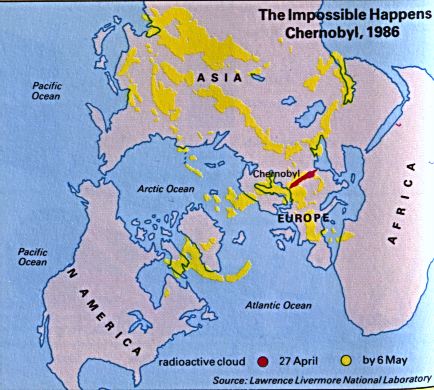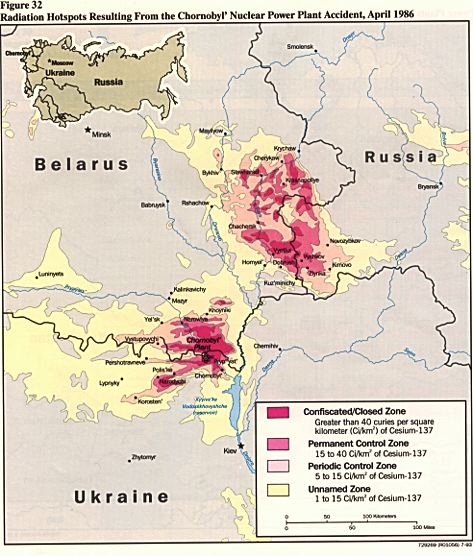The risk to the public health of the people in neighboring countries from the nuclear accident at Chernobyl, USSR, has been a primary element in evaluating the magnitude this accident has had on the world. The citizens of eastern Europe and Scandinavia are the most concerned, because their countries received the majority of the exposure in the first week of the accident and thus, their health is at the highest risk.
On Friday, April 25, 1986, as a result of human error during experiments being performed by the staff at Chernobyl, the cooling system failed resulting in the melting of fuel and, of greater importance to the public, the graphite moderator ignited and began the release of what has been approximated as 1900 PBq [1] of activity to the environment (it has been commented that had there been a containment building similar to the ones used in U.S. reactors, this value might have been greatly reduced). The most hazardous isotopes released in this accident are known to Cs-137, I-131, and Sr-90. These isotopes have half-lives sufficiently long to allow them to migrate into the body or, in the case of Iodine, have the tendency to accumulate in the thyroid gland.
The plume from the burning graphite initially traveled in a northwest direction toward Sweden, Finland and eastern Europe, exposing the public to levels up to 100 times the normal background radiation. A very serious concern involves the contamination of grain and dairy products from fallout. This contamination presents the chance for permanent internal contamination. Both Sr-90 and I-131 migrate to vital organs in the body where they are impossible to remove, serving as a constant source of unnecessary radiation and as a cause of cancer or other diseases.
Regions of heaviest fallout from the effluents from the fire at Chernobyl are shown in the figure below (Map shows borders in 1986). In these regions radiation exposure exceeded 100 mrads/h (0.1mrem/hr or 0.001mSv/hr) [4].
Click on individual countries for data on population exposure. Data reprinted from "The Chernobyl Accident and its Consequences."
The radiation cloud track much of the northern latitudes during the first week following the accident as seen in the next figure.

While the radiation field intensity eventually fell back to normal levels, exposure due to internally deposited radioactive effluents continued to provide a threat to the population. The greatest hazard came from I-131 in the thyroid. Dose estimates made on a sample of eastern European people showed that this exposure measured no more than 1 rad (1 rem) localized in the thyroid gland. In the immediate vicinity of Chernobyl contamination was extensive. Whole body exposure to internally deposited Cs-137 and Cs-134 ranged from 0.5 rem to 14 rem (5 to 140 mSv). The next figure shows the radiation levels near Chernobyl due to Cesium (Cs-137 has a half life of about 30 years).

Original predictions of the casualties were grossly overestimated but, the risk to the public health was by no means trivial. The threat of contamination from an accident like Chernobyl is widespread. Radiation discharge by means of either airborne or water modes, allows for numerous exposure pathways [2].
Airborne radioactive effluents can enter the body by air inhalation, absorption through the skin, or food consumption. Exposure immediately following the accident involved air inhalation and absorption through the skin but, this exposure could have been minimized by staying indoors. The greatest threat for the public is from food contamination. In this case, fallout settles on farmland and grazing land. Cattle consume the grass and inadvertently contaminate themselves and their by-products such as milk and meat. In the case of farmland, radioactive dust settles on the crops. If well cleaned, this source of radiation is minimized but, for the people in eastern Europe and Finland, often sanitary conditions are not available on the small family-owned farms.
Radioactive effluents in water offer similar contamination threats from drinking water, fish consumption, and absorption through the skin. Again the greatest threat is from consumption of food. Small fish absorb the effluents through their skin and gills and from ingestion. Radioactive particulates in water are also reconcentrated in the aquatic food chain. The ingestion of fish then results in internal exposure.
The biological effects from radiation vary with dose. The science of health physics recognizes two types of exposure [3]: (1) a single accidental exposure to a high dose of radiation during a short period of time, which is commonly called acute exposure, and which may produce biological effects within a short time after exposure; and (2) long-term, low level overexposure, commonly called continuous or chronic exposure, where the results of the overexposure may not be apparent for years, and which is likely to be the result of improper or inadequate protective measures.
Due to the varying sensitivity of body organs, the effects of acute whole body radiation depend on the magnitude of the dose. At lower levels (<100 rads), changes in the blood count can be expected. White blood cell count is reduced, making the body more susceptible to disease. At the same time there is also a reduction of granulocytes (essential in blooded clotting) and red blood cells. At higher levels destruction of bone marrow, the gastrointestinal system, and under very high intensity radiation, the central nervous system.
Chronic exposure can be due to exposure to external radiation fields, or can be the result of inhalation or ingestion of radioisotopes which then become fixed in the body through chemical reactions with the tissue protein or, because of the chemical similarity of the radioisotope with normal metabolites, may be systematically absorbed by certain organs and tissues. The results from chronic exposure, such as cancer or genetic mutation, often do not occur until many years after the initial exposure.
Evaluation
The radiation threat from the Chernobyl accident to the people living in eastern Europe and Finland from solely the radiation field it produced was essentially negligible considering that the total dose possibly received without any safety precautions and living in regions of high ground contamination is on the order of magnitude of 1 rad. Acute effects from this kind of radiation do not usually take affect until exposure approached 15 rads for very sensitive people.
On the other hand, the radiation effects of exposure from internal deposition exposure offer the potential for chronic affects. Table 1 shows a compilation of the potential number of cases of a radiation induced disorder vs. the usual number of people in the population getting the same affliction [8]. The equations used for incidence of disorder assumed that incidence occurs linearly with dose.
Table 1. (Nat-Natural Occurrence, R-I - Radiation Induced)
Population Dose Fatal Cancer Severe Retardation Genetic
(10e6) (10e5 man-R) Nat R-I Nat R-I Nat R-I
Eastern Europe (10e3) (10e3) (10e3) (10e3) (10e3) (10e3)
75 470 9400 11 7.2 0.27 3900 0.75
These values were calculated by considering the risk coefficients derived by the International Commission on Radiological Protection and multiplying by dose [9]. The values for radiation induced disorders are dependent solely on the amount of dose absorbed by a person. For these calculations it was assumed that the man was exposed to 1 rad directly from Chernobyl over a lifetime.
Conclusions
For a person living in eastern Europe, the occurrence of some disorder resulting from the Chernobyl Accident will not appear for several years, which is typical for chronic exposure. Immediate affects from the radiation field produced during the accident do not exist because the exposure received by eastern Europe never came close to the levels at which acute affects occur. On the other hand, the occurrence of chronic affects may never be validated because such relatively small increments are statistically indistinguishable in the face of the great variability of spontaneous cancer rates. While excess cancer fatalities may be observed within the more heavily irradiated groups within the USSR, additional mortality is unlikely to be observed elsewhere.
For the average person living in countries neighboring the USSR the accident at Chernobyl has had no affect on his physical well-being.
Footnotes
1. "Health and Environmental Consequences of the Chernobyl Nuclear Power Plant Accident," Report to the U.S. Department of Energy Office of Health and Environmental Research from the Interlaboratory Task Group on Health and Environmental Aspects of the Soviet Nuclear Accident, U.S. Government Printing
2. H. Cember, Introduction to Health Physics, Chapter 6, Pergamon Press, New York, 1983.
3. Ibid.
4. A. P. Hill, "Dose Estimates from the Chernobyl Accident," ANS Transactions, Winter 1987.
5. D. E. Fields, N. Ozluoglu, M. G. Yalcintas, "Impact of the Chernobyl Accident on Turkey", ANS Transactions, Winter 1987.
6 R. A. Schlenker, "Internally Deposited Fallout from the Chernobyl Accident," ANS Transactions, Winter 1987.
7. "Domestic Licensing of Production and Utilization Facilities", 10 CFR 50, Dept. of Energy, 1980.
8. "Recommendations of the International Commission on Radiological Protection." ICRP Publication 26, ANN. ICRP, 1 3 (1977).
9. M. Goldman, L. R. Anspaugh, P. J. Catlin, "Health and Environment Impact of the Chernobyl Accident, " ANS Transactions, Winter 1987.